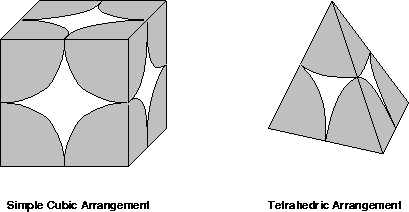Though it is often difficult to make the distinction between a rock and a suspension when the sample is incoherent, the two terms have a clear definition. We can consider a sample to be a load-bearing rock when the constitutive grains have no freedom of movement, in other words, when the grains are in contact. Conversely, a suspension consists of grains separated from one another, moving freely in the medium.
Although suspensions usually have a higher porosity than load-bearing rocks, the critical porosity varies with the nature of the rock, its degree of compaction, the grain size, and so on. Figure (1) shows two types of granular arrangement of spherical isodiametric grains that have completely different porosities. The simple cubic arrangement is the loosest possible arrangement of spheres in a volume. In this case, a simple volume calculation yields the following porosity :
| |
(1) |
| |
(2) |
Assuming that a rock is composed of single-sized, monodisperse,
spherical grains, a porosity higher than ![]() implies
a state of suspension and a porosity lower than
implies
a state of suspension and a porosity lower than ![]() implies a load-bearing rock (all grains are in contact with
their neighbors). Between these two values of porosity, the sample
may be either a suspension or a load-bearing rock.
implies a load-bearing rock (all grains are in contact with
their neighbors). Between these two values of porosity, the sample
may be either a suspension or a load-bearing rock.
Obviously, knowing only the porosity is not enough to determine whether the sample behaves like a suspension or a rock. The boundary between these two states is uncertain. However, in practice, a sand starts to behave like a suspension beyond 40 or 45 percent porosity; suspensions are never encountered below this value.
 |